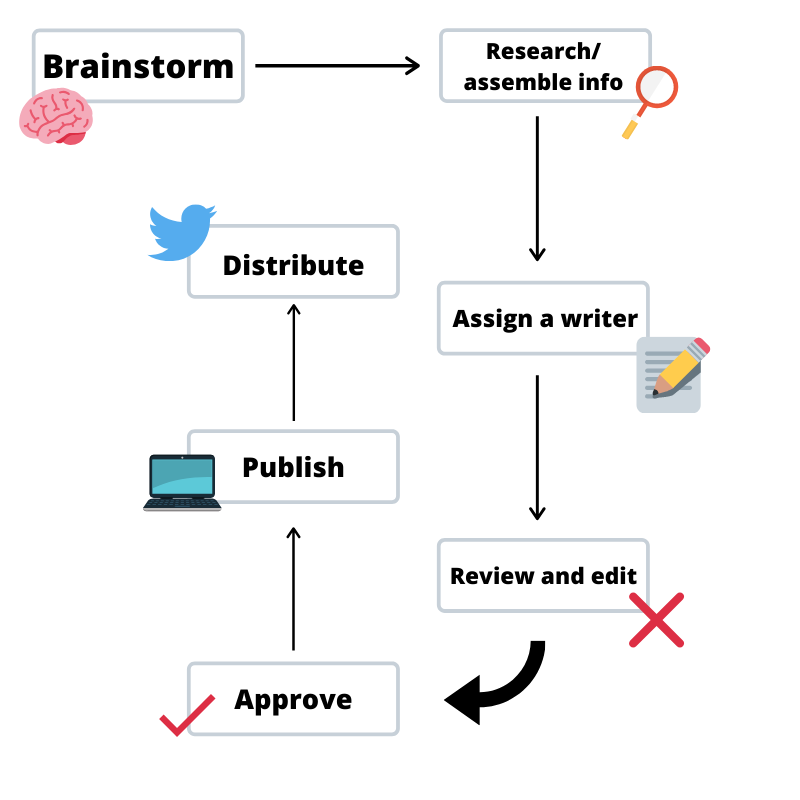How to Put Together an Editorial Calendar: A Step-by-Step Guide
February 1, 2023 5 min read

If you’re a marketer, it goes without saying that your content marketing is a huge part of your strategy. Putting together an editorial calendar to help you track, manage, and coordinate your efforts with your team is an absolute must. Honestly, I don’t think you can be serious about content marketing if you don’t have one.
Aside from keeping everyone aligned, your editorial calendar ensures you meet deadlines, think proactively about how to make your content more compelling, and provides a bird’s eye view of what piece of content is in which stage. But how do you actually go about putting one together? Where do you even start?
There are quite a few steps to creating an effective and helpful editorial calendar, and some of them start long before you begin planning your content. Here’s how to get started:
1. Identify Your Target Audience
Before you plan out the content, you need to know who you’re planning your content for. For this reason, you must start the editorial calendar process by first fully defining your audience — their interests, their needs, their biggest pain points, etc.
Begin this process by creating customer personas for the various people you’re going to be targeting with your content. Be specific, honing in on the people who are most likely to purchase and utilize your product or service and the characteristics and behaviors that they share in common, as well as the characteristics and behaviors that set each type of customer apart. If you need some help in this area, talk to your sales team. They speak and engage with your potential customers all day, so they’re a great resource here.
2. Review the Stages of the Buyer’s Journey
Each stage of the buyer’s journey requires distinct types of content. To help you understand what kinds of content you need to create, it’s beneficial to start by reviewing the three stages of the buyer’s journey, or the “sales funnel,” and decide the specifics of what will benefit your audience and spur them on to the next stage.
In the beginning stages, prospects are just becoming aware of what it is you do and who you are. So plan to create plenty of content that explains your area of expertise and your product or service offering.
When prospects reach the middle of the funnel, they’re often evaluating your company against competitors, so you need to have plenty of content focused on differentiating your brand from others.
Lastly, you’ll want to create content that will compel the bottom of the funnel prospects to become customers. You’ll need case studies, testimonials, and client feedback to give a real indication of what it is you can do for future clients.
3. Establish Which Types of Content to Create
You may be thinking, didn’t we already cover this in the previous point? But what I mean here is to outline the forms of content you’ll want to create. Diversifying your content means that you have more diverse options for what it can achieve. Here are just a few types of content to consider:
- Blog posts
- Whitepapers and other gated resources
- Landing pages
- Guest-contributed articles
- Videos
- Infographics
- Social media
- Case studies
- Customer testimonials
Note that some forms of content will serve multiple purposes — for example, guest posts on other sites will build brand awareness, help strengthen your brand authority, and can contribute to your SEO efforts.
4. Designate Your Team Members
How you designate the various roles of content planning largely depends on the size of your team, your content capacity, and your budget. Many businesses and/or marketing teams assign one person to multiple roles, which is fine, so long as the team members themselves can take on the extra work. You can also designate multiple people for one role, though if you do this, try to assign a lead as well — too many cooks in the content creation kitchen aren’t always good for productivity.
Roles to consider assigning include your strategist, your project manager, your writer(s) and editor(s), and your team member in charge of distribution. But ultimately, you just need team members that contribute to an efficient process.
5. Confirm a Content Creation Process
Nailing your content creation process is the best way to ensure you stick to your editorial calendar. Figuring out the best way your team works together is maybe the most important piece of the puzzle, and it’s essential that whatever it looks like, the focus is on maintaining quality, strategic content.
As a general rule of thumb, your content planning process should look something like this:
When you’re brainstorming, make sure you identify any keywords that will be used in the piece of content. Break down each step, if necessary, but if you stick to a flow like this, you’ll keep your content moving and your team accountable.
6. Decide How Much Content You Want to Create Each Month
The quality of your content is of the utmost importance. So, be realistic when determining your team’s capacity. More content isn’t better if it means that the quality suffers. If you have a team of three people, for example, don’t decide to create 25 pieces of content each month. Discuss as a team what you can realistically achieve. It may be that you only focus on creating one blog post a week and go from there. Plan on adjusting your content expectations as you go, taking on more or less as possible.
7. Put Together a Tracking Document
Decide how and where you’re going to organize your editorial calendar. Excel docs and Google spreadsheets are both great free options, though if you have the budget, you might want to spring for a workflow platform like Airtable or Asana.
Regardless of where you track, be sure your document indicates which stage each piece of content is in, who’s responsible for that stage, the date the piece should be published, and anything else that you deem necessary.
8. Figure Out a Distribution Plan
Your editorial calendar should also cover the distribution process, including how you’re going to use each piece of content and how you’re going to share it. Keep the buyer’s journey in mind again during this part of the planning, considering where people at each stage are most likely to come across your content, so you’re distributing to the right people at the right time.
Incorporate your content into your email marketing, which will help you personalize your nurture. Share it on social media, and send it to clients and prospects that you think could benefit from it.
Make sure you decide how often you want to update your editorial calendar. Many marketing teams choose to go month by month, but you can also plan to organize your calendar by quarter or even by year. Do what works best for you and your team.







